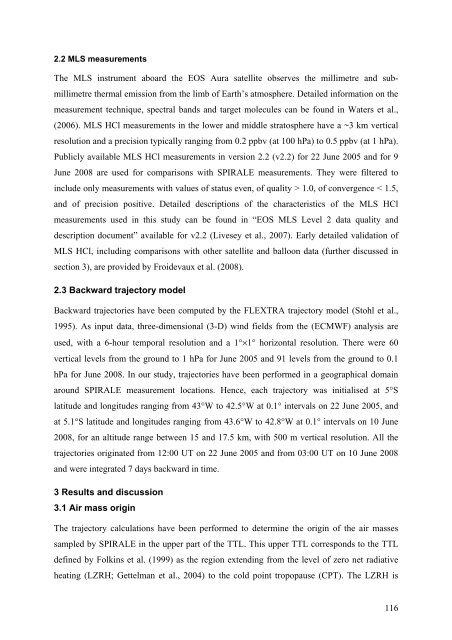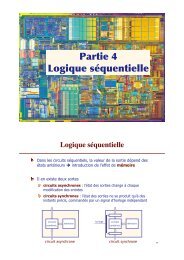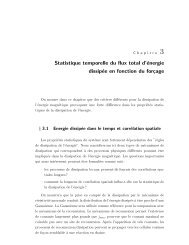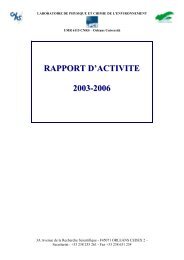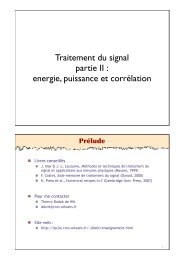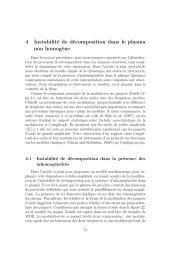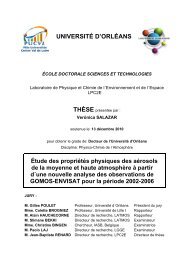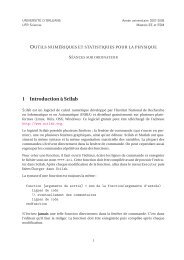UNIVERSITÉ D'ORLÉANS - Laboratoire de physique et chimie de l ...
UNIVERSITÉ D'ORLÉANS - Laboratoire de physique et chimie de l ...
UNIVERSITÉ D'ORLÉANS - Laboratoire de physique et chimie de l ...
Create successful ePaper yourself
Turn your PDF publications into a flip-book with our unique Google optimized e-Paper software.
2.2 MLS measurements<br />
The MLS instrument aboard the EOS Aura satellite observes the millim<strong>et</strong>re and sub-<br />
millim<strong>et</strong>re thermal emission from the limb of Earth’s atmosphere. D<strong>et</strong>ailed information on the<br />
measurement technique, spectral bands and targ<strong>et</strong> molecules can be found in Waters <strong>et</strong> al.,<br />
(2006). MLS HCl measurements in the lower and middle stratosphere have a ~3 km vertical<br />
resolution and a precision typically ranging from 0.2 ppbv (at 100 hPa) to 0.5 ppbv (at 1 hPa).<br />
Publicly available MLS HCl measurements in version 2.2 (v2.2) for 22 June 2005 and for 9<br />
June 2008 are used for comparisons with SPIRALE measurements. They were filtered to<br />
inclu<strong>de</strong> only measurements with values of status even, of quality > 1.0, of convergence < 1.5,<br />
and of precision positive. D<strong>et</strong>ailed <strong>de</strong>scriptions of the characteristics of the MLS HCl<br />
measurements used in this study can be found in “EOS MLS Level 2 data quality and<br />
<strong>de</strong>scription document” available for v2.2 (Livesey <strong>et</strong> al., 2007). Early <strong>de</strong>tailed validation of<br />
MLS HCl, including comparisons with other satellite and balloon data (further discussed in<br />
section 3), are provi<strong>de</strong>d by Froi<strong>de</strong>vaux <strong>et</strong> al. (2008).<br />
2.3 Backward trajectory mo<strong>de</strong>l<br />
Backward trajectories have been computed by the FLEXTRA trajectory mo<strong>de</strong>l (Stohl <strong>et</strong> al.,<br />
1995). As input data, three-dimensional (3-D) wind fields from the (ECMWF) analysis are<br />
used, with a 6-hour temporal resolution and a 1°×1° horizontal resolution. There were 60<br />
vertical levels from the ground to 1 hPa for June 2005 and 91 levels from the ground to 0.1<br />
hPa for June 2008. In our study, trajectories have been performed in a geographical domain<br />
around SPIRALE measurement locations. Hence, each trajectory was initialised at 5°S<br />
latitu<strong>de</strong> and longitu<strong>de</strong>s ranging from 43°W to 42.5°W at 0.1° intervals on 22 June 2005, and<br />
at 5.1°S latitu<strong>de</strong> and longitu<strong>de</strong>s ranging from 43.6°W to 42.8°W at 0.1° intervals on 10 June<br />
2008, for an altitu<strong>de</strong> range b<strong>et</strong>ween 15 and 17.5 km, with 500 m vertical resolution. All the<br />
trajectories originated from 12:00 UT on 22 June 2005 and from 03:00 UT on 10 June 2008<br />
and were integrated 7 days backward in time.<br />
3 Results and discussion<br />
3.1 Air mass origin<br />
The trajectory calculations have been performed to <strong>de</strong>termine the origin of the air masses<br />
sampled by SPIRALE in the upper part of the TTL. This upper TTL corresponds to the TTL<br />
<strong>de</strong>fined by Folkins <strong>et</strong> al. (1999) as the region extending from the level of zero n<strong>et</strong> radiative<br />
heating (LZRH; G<strong>et</strong>telman <strong>et</strong> al., 2004) to the cold point tropopause (CPT). The LZRH is<br />
116


